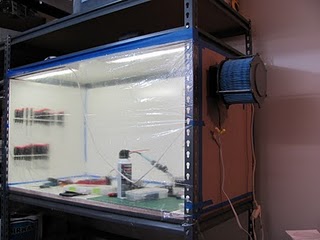DYI Garage Biotech

One day, we knew, biotech would become so easy and so cheap that two guys in a garage could hack life in the way kids hack code. That day is now here. Exhibit A is this biohacking lab in a garage in Silicon Valley. Assembled from used equipment the kit includes two clean cell-culture hoods, an incubator, two robot sequencers, and lots of software packed into a suburban garage. The guys are screening antic-cancer compounds.
Not that everyone thought a do-it-yourself biotech lab was inevitable. Many folks in the biotech industry have repeatedly explained why biotech is different, how it is far more complex than digital stuff, requiring far more education to master, how the subject is far more delicate requiring far more precision in experiments, and the equipment thus far more expensive than anything computers use, meaning overall that garage biotech hackers were very unlikely. “You need a PhD and a clean room” they would say.
Maybe you do, but Rob Carlson, who has been tracking biotech for decades, recently photographed the above pictures of the DIY biotech. He also pointed to the example of maker-types constructing DIY clean rooms, such as this one made from industrial shelving and off-the-shelf filters.

As Carlson explains:
I continue to get push back from people who assert that “it is really too hard” to hack biology in a garage, or too expensive, or that garage labs just can’t be up to snuff. This sort of dissent usually comes out of National Labs, Ivy League professors, or denizens of the beltway. All I can say to this is — Doodz, you need to get out more.
The people who built the lab pictured above are pursuing a project that is technically well beyond anything discussed on the DIYBio list, and while they may be watching the DIYBio conversation they don’t advertise what they are up to. It would be better for all of us if we could rest assured that conversations about this sort of work could proceed in the open without guys showing up in biohazard suits with weapons drawn — Youtube, at the 00:00:48 mark.
There continues to be a prominent thread of conversation in Washington DC that “biohacking” is somehow aberrant and strange. But apparently DIYBio, you’ll be happy to hear, is a group composed of the Good Guys. Everyone should feel happy and safe, I guess. Or maybe not so much, but not for the reasons you might think.
The creation of a false dichotomy between “DIY Biotech” (good guys) and “Biohacking” (bad guys) lends unfortunate credence to the notion that there is an easily identifiable group of well-meaning souls who embrace openness and who are eager to work with the government. On the contrary, in my experience there are a number of people who are actively hacking biology in their garages who intentionally keep a low profile (I am not certain how many and know of no existing measure, but see discussion above). This tally included me until a little over a year ago, though now my garage houses a boat under restoration. These people often consider themselves “hackers”, in the same vein as people who hack computers, boats (!), cars, and their own houses. Yes, it is all hacking, or Making, or whatever you want to call it, and not only is it generally
There’s a lot more in Carlson’s post which is worth reading. Indeed he has a new book out about the coming impact of cheap biotechnology, entitled: Biology is Technology
 .
.
As he says in Chapter One:
The influence of exponentially improving biological technologies is only just now starting to be felt. Today writing a gene from scratch within a few weeks costs a few thousand dollars. In ï¬ve to ten years that amount should pay for much larger constructs, perhaps a brand-new viral or microbial genome. Gene and genome-synthesis projects of this larger scale have already been demonstrated as academic projects. When such activity becomes commercially viable, a synthetic genome could be used to build an organism that produces fuel, or a new plastic, or a vaccine to combat the outbreak of a new infectious disease.
As I will discuss in Chapter 6, the costs of reading and writing new genes and genomes are falling by a factor of two every eighteen to twenty-four months, and productivity in reading and writing is independently doubling at a similar rate. We are just now emerging from the “slow” part of the curves, by which I mean that the cost and productivity of these technologies are now enabling enormous discovery and innovation. Consequently, access to technology is also accelerating. “Garage biology” is here already; in Chapter 12 I share a bit of my own experience sorting out how much innovation is possible in this context.


